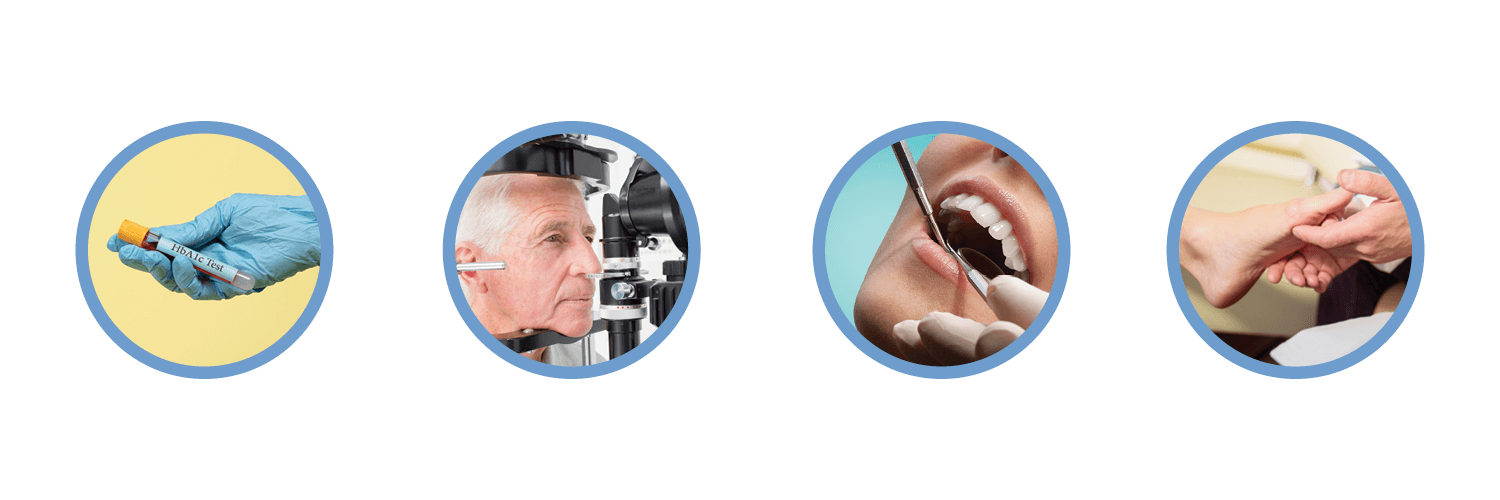Routine Diabetes Health Checks

- When it comes to caring for your diabetes, certain health checks are more important.
- Your eyes, gums and feet can show warning signs of diabetes complications. Do you know what those signs are?
- If you notice a cut or a sore on your foot, have a health care professional look at it right away. Don’t try to treat these wounds yourself.
- Many of these health checks should be started at time of diagnosis for optimal care.
In the past few years, our lives have changed in ways big and small, from how we shop to where we work to how we manage our health. Chances are that you already know how important it is to keep tabs on your diabetes and your overall health. You can manage some aspects of diabetes care yourself, and need to consult a professional for others. If you’re wondering which routine diabetes health checks are most essential, these five are recommended to help prevent long-term complications.
1 – A1C measurement: An A1C test shows the average blood glucose control over the past two to three months. This number is different from the reading you get on your glucometer. Usually, this blood test is recommended every three months when blood glucose targets are not being met or when diabetes medications are changed.
Doing this test regularly gives you and your health care provider a good idea of how well your blood glucose has been controlled since your last test. This number also allows your doctor to make therapy adjustments as needed and this number also predicts risk of future complications. Providers use your A1C number along with your home glucometer numbers to look at the overall picture of your blood glucose control. For most people, an A1C equal to or less than seven per cent (≤7%) is ideal. Studies have shown that maintaining this target reduces the risk of long-term complications of diabetes. Your health care provider can advise how often you should be getting your A1C checked and what your personal A1C goal should be.
2 – Eye exam : Having your eyes monitored regularly by an experienced professional is the best way to detect any early changes to your vision. Exams are started at diagnosis for Type 2 diabetics; for Type 1 diabetics greater than 15 years old, exams are started 5 years after diagnosis. Retinopathy is a diabetes complication that can cause vision changes and even lead to vision loss if not managed properly. Managing your blood glucose well, and having your eyes checked regularly, can reduce the risk.
For most people without diagnosed diabetic retinopathy, having an eye exam done by an optometrist or ophthalmologist every year or two is recommended. People who have type 1 diabetes should have their eyes checked every year. When diabetic retinopathy is diagnosed, appointment intervals are specific to the patient.
3 – Dental exam: Whether you have diabetes or not, going to the dentist for regular checkups is a key part of staying healthy. However, people who have diabetes are at higher risk of more serious dental conditions like gingivitis and periodontitis, which can result in pain and even tooth loss. Generally, dental checkups should be scheduled every six months.
Keep your teeth and gums healthy by following the usual oral health advice. Brush and floss your teeth twice a day. Gums that bleed with brushing or are red and swollen can indicate gum disease. Speak with a dental professional about any concerns or changes to your mouth.
4 – Foot check : People who have diabetes are at higher risk of foot infections. Diabetes can cause progressive nerve damage, which makes it harder to feel when you injure your feet. Even small injuries like blisters can go unnoticed and become infected.
Diabetes also causes reduced blood flow to the feet. This can mean wounds take longer to heal. These two factors make it very important for people who have diabetes to check their feet regularly.
Following this routine at home can help you (or your home caregiver) to notice if something is wrong.
- Examine your feet and legs every day. Look for injuries, changes in skin colour, and abnormal warmth or swelling.
- Trim your toenails straight across. Make sure they are cleaned regularly.
- If you have dry feet, use a moisturizing lotion. However, avoid using lotion between the toes as it can increase the risk of fungal infection.
- Be sure your shoes fit properly. Wear clean and dry socks each day.
- When bathing, use your hand to test that the water is not too hot before you step in. Avoid soaking your feet, as this can dry and crack your skin. Dry your feet well, especially between the toes.
- If you notice any injuries, corns, calluses, warts, or other wounds on your feet, see your doctor or foot care specialist for treatment as soon as possible. Never try to treat a foot wound yourself. Clean minor cuts or scratches with soap and water, and monitor for signs of infection. Anything more serious requires assessment by a health care professional.
- Many family doctors like to see your shoes and socks removed for your diabetes appointments.
- It is recommended that doctors check for nerve damage annually to monitor for new onset or progression of nerve damage.
In addition to daily checks, have your feet examined by a health care provider at least once a year. Be sure to check for changes in nerve sensation and blood flow to your feet. If you know that you are at higher risk for infections or amputation, have a health care provider check your feet more regularly.
5 – Kidney check :
Overtime, poorly controlled diabetes damages blood vessels in the kidneys and cause it to not work at 100%. This is a common and progressive complication among diabetics, so patients with type 1 diabetes (screening starts 5 years after diagnosis) and type 2 diabetes (screening starts at diagnosis) should be monitored annually. Depending on your provider, your kidney function is monitored using a urine and/or blood sample. There’s usually no symptoms at the early stages of kidney disease, so scheduled monitoring is important.
- Every three months, or every six months if A1C is stable and goals are met


Eye exam
- Annually for people who have type 1 diabetes
- Every one to two years for people with type 2 diabetes
- More often if signs of retinopathy are present
Dental exam
- Every six months for routine cleaning and check-up
- Brush and floss twice daily to promote oral health
Foot check
- Daily checks at home done by you or with the help of a caregiver
- Yearly check by a foot care professional, and more often if you are at high risk for infection or amputation
Kidney check
- Yearly monitoring by a health care provider
These recommendations are key aspects of managing diabetes well. Whether you have been keeping up with regular checks or are just getting back into a routine, you are taking steps in the right direction to lower your risk of long-term complications. Most importantly, prevention is key!
Resources from Diabetes Canada
Managing Your Blood Sugar » tinyurl.com/Manage-Blood-Sugar
Your Eyes and Diabetes » tinyurl.com/Diabetes-Eyes
Diabetes and Your Teeth » tinyurl.com/Diabetes-Teeth
Foot care: a step toward good health » tinyurl.com/Diabetes-Foot
WRITTEN BY: Madison Vassart, BSc Pharm, PharmD Candidate, CDE.
EDITED BY: Victoria Ayo, BSc Pharm, CDE, a pharmacist and certified diabetes educator with Safeway Pharmacy.

